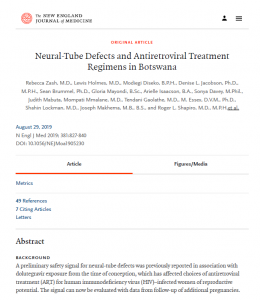
Background
A preliminary safety signal for neural-tube defects was previously reported in association with dolutegravir exposure from the time of conception, which has affected choices of antiretroviral treatment (ART) for human immunodeficiency virus (HIV)–infected women of reproductive potential. The signal can now be evaluated with data from follow-up of additional pregnancies.
Methods
We conducted birth-outcomes surveillance at hospitals throughout Botswana, expanding from 8 to 18 sites in 2018. Trained midwives performed surface examinations of all live-born and stillborn infants. Research assistants photographed abnormalities after maternal consent was obtained. The prevalence of neural-tube defects and major external structural defects according to maternal HIV infection and ART exposure status was determined. In the primary analyses, we used the Newcombe method to evaluate differences in prevalence with 95% confidence intervals.
Results
From August 2014 through March 2019, surveillance captured 119,477 deliveries; 119,033 (99.6%) had an infant surface examination that could be evaluated, and 98 neural-tube defects were identified (0.08% of deliveries). Among 1683 deliveries in which the mother was taking dolutegravir at conception, 5 neural-tube defects were found (0.30% of deliveries); the defects included two instances of myelomeningocele, one of anencephaly, one of encephalocele, and one of iniencephaly. In comparison, 15 neural-tube defects were found among 14,792 deliveries (0.10%) in which the mother was taking any non-dolutegravir ART at conception, 3 among 7959 (0.04%) in which the mother was taking efavirenz at conception, 1 among 3840 (0.03%) in which the mother started dolutegravir treatment during pregnancy, and 70 among 89,372 (0.08%) in HIV-uninfected mothers. The prevalence of neural-tube defects was higher in association with dolutegravir treatment at conception than with non-dolutegravir ART at conception (difference, 0.20 percentage points; 95% confidence interval [CI], 0.01 to 0.59) or with other types of ART exposure. Major external structural defects were found in 0.95% of deliveries among women exposed to dolutegravir at conception and 0.68% of those among women exposed to non-dolutegravir ART at conception (difference, 0.27 percentage points; 95% CI, −0.13 to 0.87).
Conclusions
The prevalence of neural-tube defects was slightly higher in association with dolutegravir exposure at conception than with other types of ART exposure at conception (3 per 1000 deliveries vs. 1 per 1000 deliveries). (Funded by the National Institutes of Health.)